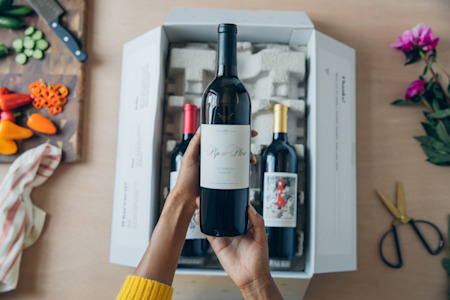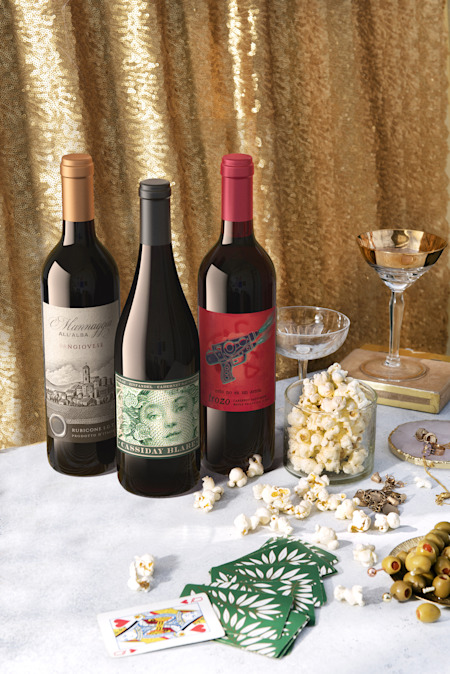Fun Wine Facts
Here are a few of our favorite wine facts and stories
Wine is a fun subject to discuss, read about, and taste. More and more it's the stories that keep us coming back for more. We want to know what winemakers are doing to make our wine, we want to know about the fields and regions they come from, and we want to know about the quality. Sometimes with wine the story is as fun than the tasting. There's so much trivia and so many fun wine facts.
We've started collecting our favorite wine facts and stories and will be putting them here for you to enjoy. Whether you're new to wine or a wine expert, you'll definitely learn a new wine fact,and if you have a fun fact or story of your own please share them with us!

Sign up for the Club Today
Join Firstleaf to taste delicious wines from all over the world and learn more about these grapes. The club has featured amazing examples, take the quiz to get the pairings for your individual palate.
Take Our QuizIN THIS ARTICLE:
Want personalized wines?
Get your first box of wines for $44.95 + free shipping.

A Grape's True Colors
Did you know that the color for red wine comes from the grape skins and not the grape juice? If you don't believe us buy some red grapes and crush them in your hands, the juice is clear. This is actually how we get rosé and some white wines. Champagne Blanc de Noirs (meaning white from black) is made with red grapes, but the final product is white.
Out of the thousands and thousands of wine grape varietals that are used for winemaking, only two dozen or so Teinturier grapes have red flesh. The two most often encountered are Alicante Bouschet and Rubired which are used to give deeper color to wines in Southern France and Central California.
Really Old Wine
How long have we been making wine as a species? The answer might be surprising. It wasn't invented by the Romans...or the Greeks...or even the Egyptians. Currently, the oldest known winemaking site is in the country of Georgia and dates back to 6,000 B.C.!
Winemakers there are still using the same wine production processes as their ancestors by harvesting, macerating, and burying the wine in large clay pots known as Kvevri. So if you want a taste of history, track down some Georgian wine.
The First New World Winemakers
Around the year 1000 A.D., Norse Viking Leif Eríksson left Iceland and Greenland for North America. He called his settlement Vinland, and while we can't be fully sure, there is evidence that this was due to the wild grape varieties growing on the shores that were used to make wine.
The Oldest Surviving Bottle of Wine
While the oldest wine production sites in the world are in Georgia, sadly no actual ancient wine remains. Long before the wine bottle, vessels were made of clay and in the ensuing millennia have broken or evaporated. So what is the oldest surviving bottle of wine?
The "world's oldest bottle" dates back to 325 A.D. and belonged to Roman nobleman in what is now Speyer, Germany.
Don't bust out the wine glasses yet. All the alcohol has evaporated and the mixture left in the bottle is unknown. Allegedly, museum employees are afraid to move it, much less pour a glass of wine.
The History of the Toast
There's nothing like offering a toast of sparkling wine at a wedding or toasting your friends on a night out. But why do we do this?
The true origins of bumping glasses are lost, but we do know that the ancient Greeks would drink to one another's health. It was part of a code of conduct known as Xenia. Supposedly the Romans literally put toast in their wine to leech out some of the acidity, and although this next idea can't be proven, others claim it was to prove you hadn't poisoned a rival's drink. Regardless, we will continue raising our wine glasses and saying cheers.

Shop Award-Winning Wines
Find a new favorite bottle of wine in our wine store and raise a toast. Shop by color, varietal, region, and more.
Shop Wines NowIs Wine Healthy? A Long-Standing Debate
Medicine has come a long way, but there were some practices in Ancient Greece that prioritized wine as a major healing component. Hippocrates, the father of modern medicine, believed that wine was a healing agent. To him, it was a disinfectant, medicine, a carrier for other drugs, and part of a nutritional diet.
His ideas carried over to Ancient Rome where they were written about by Galen. Then this continued into the dark ages in Monasteries as well as in Islamic medicine that eventually made it's way back to Europe. Even in the 1600s German doctors prescribed two liters of wine per patient per day. To drink wine, was to live a healthy life.
Afraid of Wine?
If you are afraid of wine it's likely you have Oenophobia.
Zinfandel, An American Classic, Or Maybe Not?
Zinfandel (pronounced zihn-fan-dell) has a story that tells itself backward. For many years the origins were unknown, it was considered a California grape variety. But through painstaking research by scientists at UC Davis we finally know where it came from.
The first mentions of Zinfandel were under a few slightly different names ("Zinfardel" and "Zinfindal") on the east coast of the United States in the middle of the 19th century. Regardless of the name, Zinfandel vines made their way to California with the Gold Rush and it has grown there ever since.
Carole Meredith, a noted grape geneticist at UC Davis wanted to know the origins of the grape, and through hard work and some happenstance was able to track down the origins of Zinfandel.
Using genetic testing she was able to determine that Italian Primitivo was actually the same grape, and by working with other scientists they were able to narrow down their search for the origins of the grape to the Dalmatian Coast of Croatia. By combing through many Croatian vineyards and testing the grapes she stumbled onto a once in a lifetime discovery: nine vines of Zinfandel (pronounced zihn-fan-dell) has a story that tells itself backward. For many years the origins were unknown, it was considered a California grape. But through painstaking research by scientists at UC Davis we finally know where it came from.
The first mentions of Zinfandel were under a few slightly different names ("Zinfardel" and "Zinfindal") on the east coast of the United States in the middle of the 19th century. Regardless of the name, Zinfandel vines made their way to California with the Gold Rush and it has grown there ever since.
Carole Meredith, a noted grape geneticist at UC Davis wanted to know the origins of the grape, and through hard work and some happenstance was able to track down the origins of Zinfandel.
Using genetic testing she was able to determine that Italian Primitivo was actually the same grape, and by working with other scientists they were able to narrow down their search for the origins of the grape to the Dalmatian Coast of Croatia. By combing through many Croatian vineyards and testing the grapes she stumbled onto a once in a lifetime discovery: nine vines of Crljenak Kaštelanski growing in a field of thousands of other grapes that directly matched the genetic makeup of Zinfandel. The mystery was solved!
Since then clones of the original vines have been planted across vineyards in California. Some of the most well-known producers (including Ridge Vineyards) have taken an interest in the wine and produce incredible bottles. growing in a field of thousands of other grapes that directly matched the genetic makeup of Zinfandel. The mystery was solved!
Since then clones of the original vines have been planted across vineyards in California. Some of the most well-known producers (including Ridge Vineyards) have taken an interest in the wine and produced incredible bottles.
Why Do We Taste Wine?
Wine tasting is a bit of a misleading statement. We can taste wine, to an extent, but more accurately we are smelling wine. Most of what we "taste" is actually smell as it moves across our olfactory sense.
When we taste wine we are actually evaluating the texture of a wine. Your tongue works to find out what the acidity is like, if there are any tannins and what kind, what is the alcohol percentage, and so on.
Certain people are considered "super-tasters" and are extra sensitive to flavor compounds. It's a blessing and a curse as many super-tasters are particularly picky eaters because of their abilities.
The Sideways Effect
In 2004 the movie Sideways starring Paul Giamatti debuted and was a critical and commercial success. Throughout the movie, he lovingly talks about Pinot Noir and criticizes Merlot.
Merlot sales dropped 2% because of the movie, but Pinot Noir sales skyrocketed. The Wine Industry came to call this "the Sideways effect." Unsurprisingly Cabernet Sauvignon and Chardonnay were still the most sold grape varietals.
Expensive Bottles of Wine
Everyone's view of an "expensive" bottle of wine is different, but these bottles are not up for debate. They are very expensive. You might be surprised that the most expensive bottle ever sold didn't come from Bordeaux or Burgundy, but from California.
At a charity auction, one man spent $500,000 on one 6 liter bottle (that's 8 regular sized bottles) of Napa cult-classic Screaming Eagle.
If you are shopping current releases the title for most expensive wine goes handily to Burgundy. According to wine-searcher, 8 of the top 10 most expensive current releases come from Burgundy. The other wine regions aren't even French. A German Riesling from the Mosel Valley and a bottle of Tawny Port round out the list, sorry Bordeaux!
IN THIS ARTICLE
Want personalized wines?
Get your first box of wines for $44.95 + free shipping.


WinePrint™ by Firstleaf
Are you looking to learn more about your wine preferences? Check out our Wine Print for an in-depth look at your personal tasting profile. Discover your favorite wines, varietals, regions, and tasting notes and get personalized recommendations wherever you are.
Learn More